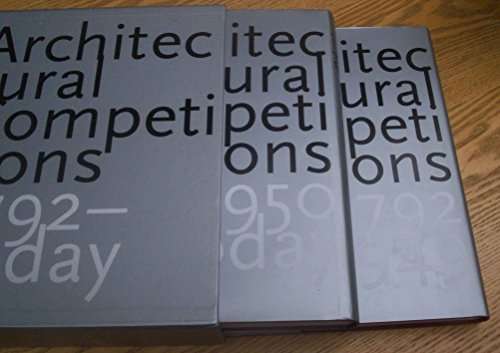TWO VOLUME BOXED SET, published by Taschen, Köln, 1994, hardcovers, illustrated, large format, condition: as ne
Cees de Jong / Erik Mattie, Architectural Competitions (2 vols 1792-1949 & 1950-today.
Winner of the 1995 International Architecture Book Award Citation for Excellence, this two-volume set provides a detailed chronological overview of major international architectural competitions organized over the last 200 years - from the White House in Washington to the new Reichstag in Berlin. There is no single formula for competitions. There are those which are open to any architect for which there is no remuneration, only the hope of immortality, those which are initially open then closed to a few invited architects who are usually paid something for their efforts, there are those that are closed at the outset, those that are mixed. The Cardiff Bay Opera House is the most reknowned recent example of the mixed category, where a selection of celebrated architects are guaranteed a payment, while the rest hope. In this case, one of the rest, Zaha Hadid made it all the way, despite the scandalous prevarications of the organisers. Then there are competitions which are local, national and international. Often the main reason for international competitions, of whichever variety, is prestige not only for the architect who wins but more fundamentally, for the organising agency, town or country itself; and hopefuly the pride that comes from its successful realisation. De Jong and Matties two handsome and beautifully printed volumes give the reader an insight into the successes, controversies and failures of architectural competitions as a mechanism to secure public architecture. The authors have selected, from their research of precisely the last two hundred years, forty nine competitions, of which only four were non-public commissions.
The volumes should therefore offer much to an understanding of how public competitions have been organised, how architects responded and how and by whom they were judged, and ultimately reveal what can be learnt from them by public agencies who are contemplating the architectural competition as the method to secure the best architectural solutions. But what is an architectural competition? It is not as obvious as it may seem. Its constituent elements are a client with an objective, a design brief, competition conditions, competitors, a jury, a result and a winning design which is built. This is the architectural competition we think of as normal, and when all of these elements are well structured the architectural competition should be succesful. However, for those who have competed and been involved in them in various ways , the normal architectural competition is indeed rare. The enormous qualitative variation which can and does occur in the aforementioned constituent elements inevitably makes comparisons between competitions impossible. Competitions seem inevitably to court controversy even scandal yet they have survived with differing degrees of success and respectability in different countries. and these two books reveal the diversity of them. t is noteworthy that the number of architectural competitions in any given town or country appears to reflect directly its selfesteem and economic strength. It is true of Victorian England and Franz-Josefs Austro-Hungarian Empire, as much as it is true more recently of France, Germany or Japan.
A HANDSOME LARGE COFFEE-TABLE SET.

